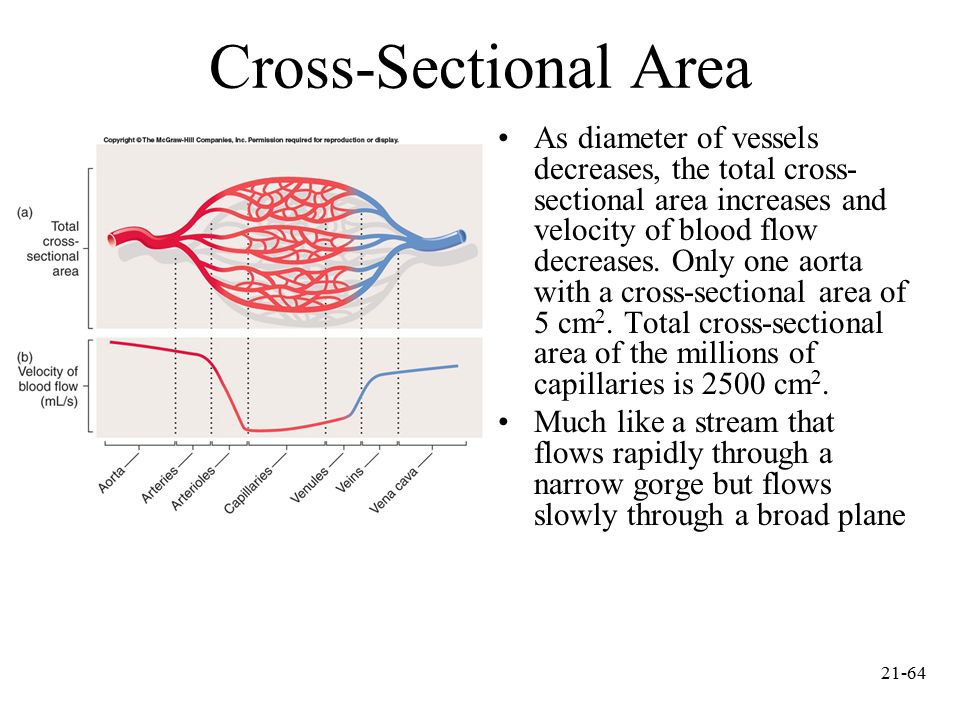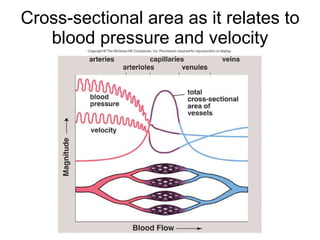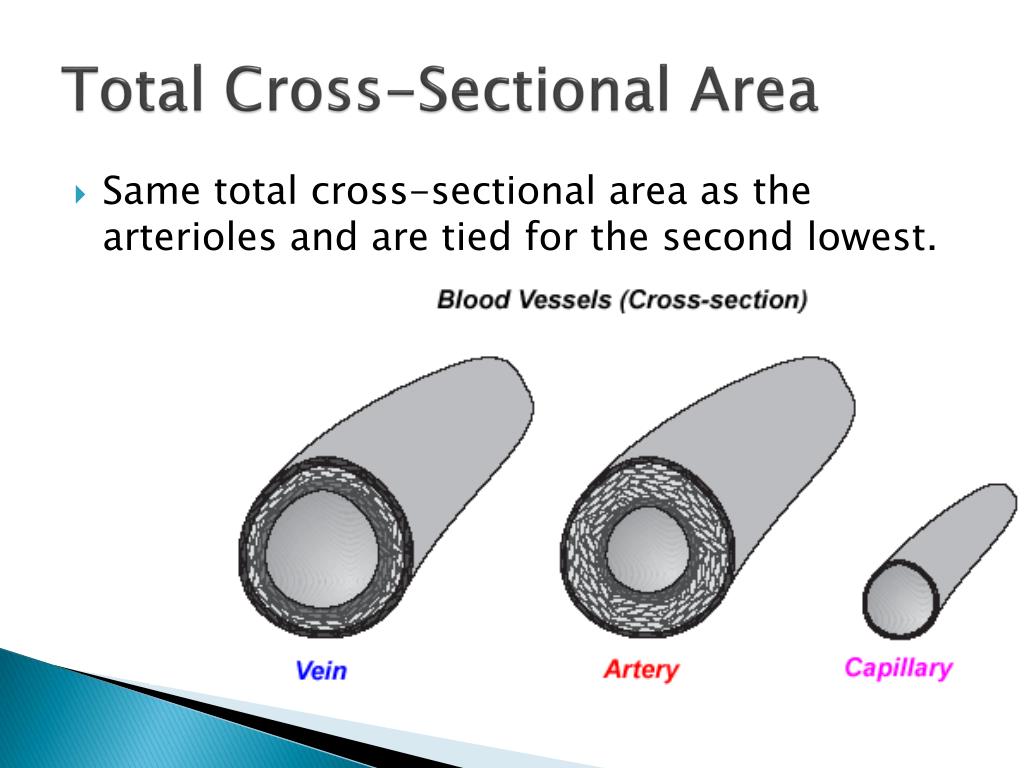Total Cross Sectional Area of Capillaries
So the cross sectional area of one capillary is pi times its diameter squared over four so well substitute that in for little a and then well solve for nc by multiplying both sides by four over pi d squared. The velocity of blood flow is ________.

Solved Arteries Arterioles Capillaries Venules Veins Mm Chegg Com
6 rows Total cross sectional area of capillaries.

. Capillary beds are the site of. B slowest in the capillaries because the total cross-sectional area is the greatest. Monday December 29 2014.
The largest total cross-sectional area of blood vessels is found in this region along the vasculature. As the total cross-sectional area of the vessels increases the velocity of flow decreases. Blood flow is slowest in the capillaries which allows time for exchange of gases and nutrients.
Solutions for Chapter 12 Problem 7PE. This passes through capillaries the smallest blood vessels. But questions asking about vascular velocity are often asking you in the context of total cross-sectional flow.
This statement is false. A T Nπ r 2. Theres the classic example of the circulatory system as a circuit with the heart as.
The total cross-sectional area of all capillary of a certain persons circulatory system is 025 m2. AP 2 - 217- Physioogy of Systemic circulation. Capillary beds dont have a total cross-sectional area much smaller than the total cross-sectional area of major arterie and they dont join of arteries and veins.
Because velocity is dependent on overall cross sectional area capillary blood velocity is the lowest. College Physics for AP Courses 1st Edition Edit edition. Asked Aug 6 2017 in Anatomy Physiology by LadyMismatch.
Capillaries have the largest cross-sectional area. The total cross-sectional area of capillaries exceeds that of arteries. Capillary hydrostatic pressure which is a direct reflection of mean arterial pressure or blood pressure.
A Small arteries B Arterioles C Capillaries D Venules E Small veins. Blood flow is slowest in the capillaries which allows time for exchange of gases and nutrients. It is right that Artery to Arteriole to Capillaries narrowing occurs But we consider Total Cross sectional areaIt means if i put these vessels of same length than suppose I have One aorta consider its cross section area suppose 2Then i have suppose 20 arteries since one artery is narrower than aorta so its cross section area is suppose 1 less than aorta but they are 20 so.
When considering the segments of the circulation the large arteries have the largest total cross-sectional area. The total cross-sectional area A T occupied by a given segment or type of blood vessel eg the capillaries can be calculated as the product of the average cross-sectional area and the total number N of such vessels. As blood circulates from arteries into capillaries the total cross-sectional area of capillaries.
The velocity of blood flow is in direct proportion to the total cross-sectional area of the blood vessels b slower in the arteries than in capillaries because arteries relatively large diameter slower in the veins than in the capillaries because veins diameter slowest in the capillaries b c. Thats why the blood velocity is the slowest through capillaries this is very important since this is the site of nutrient exchange and you want blood to slow down to allow proper exchange rather than rush past. This problem has been solved.
Ecause the total cross-sectional area is the 27. C What is the area. In blood vessels most of the resistance is due to vessel diameter.
Table - link cm2. Have a large d. If the blood speed increases by a factor of 400 and the total crosssectional area of the venules is 100 cm2 what is the total cross-sectional.
A slower in the veins than in the capillaries because veins have a large diameter. Resistance is a force that opposes the flow of a fluid. A decreases and causes the blood velocity to decrease.
A As blood passes through the capillary bed in an organ the capillaries join to form venules small veins. The total cross-sectional area of all capillaries is greater than the cross-sectional area of the aorta. The primary mechanism driving filtration in capillary beds is _____.
In blood vessels most of the resistance. The total cross-sectional area of the capillaries is the greatest. B What is the total cross sectional area of all of the capillaries.
A in direct proportion to the total cross-sectional area of the blood vessels B slower in the arteries than in capillaries because arteries possess a relatively large diameter C slower in the veins than in the capillaries because veins have a large diameter D slowest in the capillaries because the total cross-sectional area is the greatest. A typical capillary is 6 microns in diameter and 1 millimeter long and the blood flows through it at an average speed of 1 mms. Smaller area faster velocity to maintain flow rate.
Capillary beds have the greatest TOTAL cross-sectional area but are composed of individual vessels that are smaller than any other type in the body. Actually the capillaries are the ones that connect arteries and veins. If the blood flows through the system at the rate of 100 cm3sec the velocity of the blood in the capillaries is.
B is the same as the total cross-sectional area of arteries and blood velocity is equal between arteries and capillaries. C in direct proportion to the total cross-sectional area of the blood vessels. As the total cross-sectional area of the vessels increases the velocity of flow decreases.
Furthermore what has the greatest cross sectional area. The rate or velocity of blood flow varies inversely with the total cross-sectional area of the blood vessels. Blood circulates at a rate of 25 Lmin.
Since there are far more capillaries in the body summing all of their cross sectional area this total is larger than the total for any other type of vessel causing the velocity of the blood to decrease. And we get the number of capillarie is four times its total area of all capillaries divided by pi times the diameter of one capillary squared. A in direct proportion to the total cross-sectional area of the blood vessels B slower in the arteries than in capillaries because arteries possess a relatively large diameter C slower in the veins than in the capillaries because veins have a large diameter D slowest in the capillaries because the total cross-sectional area is the greatest.

Chapter 8 Transport In Humans Lesson 2 Types Of Blood Vessels

Associate Degree Nursing Physiology Review
What Is The Relationship Between The Cross Sectional Surface Area And Blood Speed Of The Blood Capillary Quora

Arteries And Veins The Cardiovascular System Medical Physiology 2e Updated Edition With Student Consult Online Access 2e Medical Physiology Boron 2nd Ed

Total Cross Sectional Area And Blood Flow Velocity Diagram Quizlet

Arteries Transport Blood Away From The Heart And Typically Carry Oxygenated Blood

20 6 Velocity Of Blood Flow Flashcards Quizlet

Peripheral Circulation And Regulation 1 Peripheral Circulatory System

3 Area And Volume Contained In Systemic Blood Vessels The Blood Download Scientific Diagram

Chapter 21 Lecture Outline Ppt Download

What Is The Relationship Between The Cross Sectional Surface Area And Blood Speed Of The Blood Capillary Quora

Ppt Venules Powerpoint Presentation Free Download Id 2259329

Molecular And Cellular Physiology Of Vascular Endothelial Cells Flashcards Quizlet
Printed From Student Consult Berne And Levy Physiology 6e The Online Medical Library For Students Plus Usmle Steps 123 Ver 2 9

Cardiovascular Disorders Vascular Disease Pathophysiology Of Disease An Introduction To Clinical Medicine Lange Medical Books 7th Ed

Comments
Post a Comment